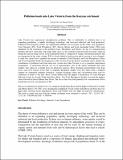| dc.description.abstract | Lake Victoria has experienced eutrophication problems. This is attributable to pollution due to an
expanding population, a rapidly developing technology, and increased industrial and food production.
Pollution from non-point sources can significantly influence an ecosystem. In this study, four parameters;
Total Nitrogen (TN), Total Phosphorus (TP), Silicon (Silica) and Total Suspended Solids (TSS) were
identified for the estimation of the pollution loads. Phosphates and Nitrates are the two principal plant
nutrients that most often limit crop yields while silica is a key nutrient in diatom production and is taken up
during the early growing season. Total Suspended Solids is comprised of organic and mineral particles that
are transported in the water column. TSS is closely linked to land erosion and to erosion of river channels.
A study was carried out to quantify the amount of nutrients (Total Nitrogen, and Total Phosphorus), Silica
and Total Suspended Solids discharging into Lake Victoria from the Kenyan catchment and to identify the
contribution of pollution load from each river system into Lake Victoria so as to prioritise intervention
programmes. A monitoring network was set at representative sites in the whole catchment and water
samples were taken on a regular basis for laboratory analysis. River discharge measurements were done
across each river transect at the time of sampling. Integrated samples were also taken using a sediment
sampler for suspended sediment estimation. Average discharge values and concentration were used for
estimation of loads to the lake. River Awach Kibuon had the highest concentration of Total Nitrogen
followed closely by Awach Tende then River Kuja. For Total Phosphorus Nyando river had the highest
value followed by River Kibuon then Nzoia. The rest of the rivers had generally low concentrations. River
Sondu had very low concentrations of TP.
Silicon concentration in all the rivers was moderate though Kuja River had the highest followed by Nyando
and Kibuon Rivers. For TSS, rivers draining Kisii highlands Awach Tende and Kiboun and Kuja had very
high values showing serious degradation. Nzoia and Nyando were also high. Sio had low concentrations.
The loads in tonnes per year from the studied catchment were estimated as follows: TN – 12,193, TP –
2,113, Si – 140,849 and TSS – 4,390,644 | en_US |

